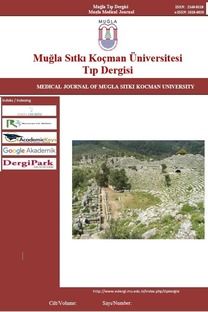Otizm Spektrum Bozukluğu Olan Olgularda Anne Sütü Alım Süreleri ve Otizm Şiddetiyle İlişkisi
Anne Sütü, Otizm, Otizm Şiddeti
Duration of Breastfeeding and Its Relationship with Autism Severity in Cases with Autism Spectrum Disorder
Autism, Autism Severity, Breastfeeding,
___
- 1. American Psychiatric Association and American Psychiatric Association DSM-5 Task Force. Diagnostic and Statistical Manual of Mental Disorders: DSM-5. Washington, DC: American Psychiatric Association, 2013.
- 2. Geier DA, Kern JK, Geier MR. The biological basis of autism spectrum disorders: Understanding causation and treatment by clinical geneticists. Acta Neurobiol Exp. 2010; 70:209-26.
- 3. Herbert MR. Contributions of the environment and environmentally vulnerable physiology to autism spectrum disorders. Curr Opin Neurol. 2010; 23:103-10.
- 4. Mandy W, Lai MC. Annual research review: The role of the environment in the developmental psychopathology of autism spectrum condition. J Child Psychol Psychiatry. 2016;57(3):271–92.
- 5. Fujiwara T, Morisaki N, Honda Y, et al. Chemicals, nutrition, and autism spectrum disorder: a minireview. Front Neurosci. 2016;10:174.
- 6. Lyall K, Schmidt RJ, Hertz-Picciotto I. Maternal lifestyle and environmental risk factors for autism spectrum disorders. Int J Epidemiol. 2014;43(2):443–64.
- 7. Wang C, Geng H, Liu W, et al. Prenatal, perinatal, and postnatal factors associated with autism: a meta-analysis. Medicine (Baltimore). 2017;96(18):e6696.
- 8. Williams K, Brignell A, Prior M, et al. Regression in autism spectrum disorders. J Paediatr Child Health. 2015;51(1):61–4.
- 9. Jones W, Klin A. Attention to eyes is present but in decline in 2–6- month-old infants later diagnosed with autism. Nature. 2013;504(7480): 427–31.
- 10. Figueiredo B, Canario C, Field T. Breastfeeding is negatively affected by prenatal depression and reduces postpartum depression. Psychol Med. 2014; 44:927–36.
- 11. Raju TN. Breastfeeding is a dynamic biological process—not simply a meal at the breast. Breastfeed Med. 2011; 6:257–9.
- 12. Al-Farsi YM, Al-Sharbati MM, Waly MI, et al. Effect of suboptimal breast-feeding on occurrence of autism: a case-control study. Nutrition. 2012;28(7-8):e27–32.
- 13. Shafai T, Mustafa M, Hild T, et al. The association of early weaning and formula feeding with autism spectrum disorders. Breastfeed Med. 2014;9(5):275–6.
- 14. Steinman G. Can the chance of having twins be modified by diet? Lancet. 2006;367(9521):1461–2.
- 15. Boucher O, Julvez J, Guxens M, et al. Association between breastfeeding duration and cognitive development, autistic traits and ADHD symptoms: a multicenter study in Spain. Pediatr Res. 2017;81(3):434–42.
- 16. Schultz ST, Klonoff-Cohen HS, Wingard DL, et al. Breastfeeding, infant formula supplementation, and Autistic Disorder: the results of a parent survey. Int Breastfeeding J. 2006;1:16.
- 17. Husk JS, Keim SA. Breastfeeding and autism spectrum disorder in the national survey of children’s health. Epidemiology. 2015;26(4): 451–7.
- 18. Schopler E, Reichler RJ, DeVellis RF, et al. Toward objective classification of childhood autism: childhood Autism Rating Scale (CARS). J Autism Dev Disord 1980; 10:91-103.
- 19. İncekaş S. Çocukluk Otizmini Derecelendirme Ölçeği Geçerlik ve Güvenirlik Çalışması. Yayım-lanmamış Uzmanlık Tezi, İzmir, Dokuz Eylül Üniversitesi Tıp Fakültesi Çocuk ve Ergen Ruh Sağlığı ve Hastalıkları ABD, 2009.
- 20. Krol KM, Grossmann T. Psychological effects of breastfeeding on children and mothers. Bundesgesundheitsblatt Gesundheitsforschung Gesundheitsschutz. 2018;61(8):977-85.
- 21. Krol KM, Rajhans P, Missana M, et al. Duration of exclusive breastfeeding is associated with differences in infants’ brain responses to emotional bodyexpressions. Front BehavNeurosci. 2015; 8:459.
- 22. Munesue T, Yokoyama S, Nakamura K, et al. Two genetic variants of CD38 in subjects with autism spectrum disorder and controls. Neurosci Res. 2010; 67:181–91.
- 23. Feldman R, Zagoory-Sharon O, Weisman O, et al. Sensitive parenting is associated with plasma oxytocin and polymorphisms in the OXTR and CD38 genes. Biol Psychiatry. 2012; 72:175–81.
- 24. Manohar H, Pravallika M, Kandasamy P, et al. Role of exclusive breastfeeding in conferring protection in children at-risk for autism spectrum disorder: results from a sibling case–control study. J Neurosci Rural Pract. 2018; 9(1): 132-6.
- 25. Bittker SS, Bell KR. Acetaminophen, antibiotics, ear infection, breastfeeding, vitamin D drops, and autism: an epidemiological study. Neuropsychiatr Dis Treat. 2018; 14: 1399-414.
- 26. James WH. A potential explanation of some established major risk factors for autism. Dev Med Child Neurol. 2012; 54(4):301-5.
- 27. Hong L, Ziegler J, Brody R. Breastfeeding and autism spectrum disorders. Topics in Clinical Nutrition. 2014; 29(3): 278-85.
- 28. Bar S, Milanaik R, Adesman A. Long-term neurodevelopmental benefits of breastfeeding. Curr Opin Pediatr. 2016; 28(4): 559-66.
- 29. Tseng PT, Chen YW, Stubbs B, et al. Maternal breastfeeding and autism spectrum disorder in children: A systematic review and meta-analysis. Nutritional neuroscience. 2017;1-9.
- 30. Tseng PT, Chen YW, Stubbs B, et al. Maternal breastfeeding and autism spectrum disorder in children: A systematic review and meta-analysis. Nutr Neurosci. 2017:1-9. doi: 10.1080/1028415X.2017.1388598.
- ISSN: 2148-8118
- Yayın Aralığı: Yılda 3 Sayı
- Başlangıç: 2014
- Yayıncı: Muğla Sıtkı Koçman Üniversitesi
Deneysel Kronik Pankreatitte N-Asetil Sistein Uygulamasinin Pankreatik Fibroz Üzerine Etkisi
Ramazan ÖCAL, İlker TAŞÇI, M. Salih DEVECI, Bilgin CÖMERT, Ahmet Turan ISIK, M. Refik MAS
Otizm Spektrum Bozukluğu Olan Olgularda Anne Sütü Alım Süreleri ve Otizm Şiddetiyle İlişkisi
Nilfer ŞAHİN, Damla BALKAN, Ulviye KIRLI
Farklı Tiroid Patolojilerinin Ayrımında Nötrofil Lenfosit Oranının Prediktif Rolü
İbrahim ATAK, Lütfi POLAT, Tuba ATAK
Güray KOÇ, Semai BEK, Zeki GÖKÇİL
Sağ Akciğerde Horizontal Fissür Yokluğu
Mehmet İlkay KOŞAR, Ceren UĞUZ GENÇER, Hasan TETİKER
Vücut Geliştiricide İntramuskuler Synthol Enjeksiyonuna Bağlı Lipoid Pnömoni
Nesrin ÖCAL, Armağan GÜNAL, Yakup ARSLAN, Berat KAÇMAZ, Ali COŞKUN, Bahadır Can KARAN, Deniz DOĞAN, Cantürk TAŞCI, Ergun UÇAR
Plazmaferez Sırasında Fatal Seyreden TRALI
Canan GÜRSOY, Ezgi DÖNMEZ, Semra GÜMÜŞ DEMİRBİLEK
Tavşanlarda Horizontal Menisküs Yırtık Modellerinde Primer ve Kollajen Skafold ile İyileşme
Cem Yalın KILINÇ, Uğur TİFTİKÇİ, Sancar SERBEST, Mustafa TÜRK, Siyami KARAHAN
